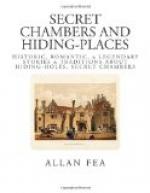[Illustration: PAXHILL, SUSSEX]
[Illustration: CLEEVE PRIOR MANOR HOUSE, WORCESTERSHIRE]
The old moated hall Baddesley Clinton, in Warwickshire, the ancient seat of the Ferrers, has a stone well or shaft near “the chapel.” There were formerly projections or steps by which a fugitive could reach a secret passage extending round nearly two sides of the house to a small water-gate by the moat, where a boat was kept in readiness. Adjoining the “banqueting-room” on the east side of the building is a secret chamber six feet square with a bench all round it. It is now walled up, but the narrow staircase, behind the wainscoting, leading up to it is unaltered.
Cleeve Prior Manor House, in Worcestershire (though close upon the border of Warwickshire)) famous for its unique yew avenue, has a priest’s hole, a cramped space five feet by two, in which it is necessary to lie down. As at Ingatestone, it is below the floor of a small chamber adjoining the principal bedroom, and is entered by removing one of the floor-boards.
Wollas Hall, an Elizabethan mansion on Bredon Hill, near Pershore (held uninterruptedly by the Hanford family since the sixteenth century), has a chapel in the upper part of the house, and a secret chamber, or priest’s hole, provided with a diminutive fire-place. When the officiating priest was about to celebrate Mass, it was the custom here to spread linen upon the hedges as a sign to those in the adjacent villages who wished to attend.
A hiding-place at Treago, Herefordshire (an unique specimen of a thirteenth-century fortified mansion) inhabited by the Mynor family for more than four hundred years), has quite luxurious accommodation—a sleeping-place and a reading-desk. It is called “Pope’s Hole.” The walls on the south-east side of the house are of immense thickness, and there are many indications of secret passages within them.
[Illustration: BADDESLEY CLINTON, WARWICKSHIRE]
Some fifty years ago a hiding-hole was opened in a chimney adjoining “the chapel” of Lydiate Hall, Lancashire; and since then one was discovered behind the rafters of the roof. Another ancient house close by contained a priest’s hole where were found some religious books and an old carved oak chair.
Myddleton Lodge, near Ilkley, had a secret chapel in the roof, which is now divided up into several apartments. In the grounds is to be seen a curious maze of thickly planted evergreens in the shape of a cross. From the fact that at one end remain three wooden crosses, there is but little doubt that at the time of religious persecution the privacy of the maze was used for secret worship.




